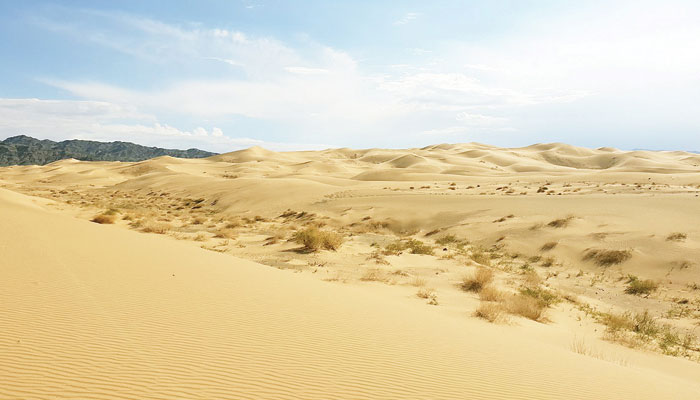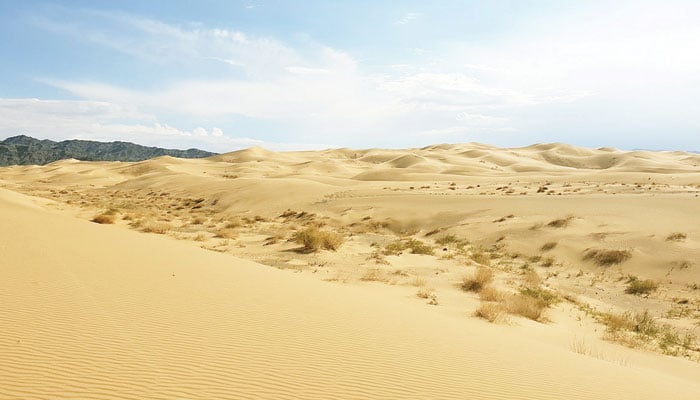
A desert or a desert is a waterless area of the earth where there is no life, and if there is only a few thorny desert dry bushes (whose roots absorb water from deep in the earth) and These arid and barren regions cannot live without being affected by the amount of solar energy emitted by the clear cloudless sky during the day.
This is why no one can spend more than a few hours in the most extreme heat. Except for those geologists and other research institutes who have special protective clothing and necessary equipment with water available all the time for the purpose of research, but the nights in these areas are not good either, because when the sun breaks across the horizon of the desert. As the sun sets, the temperature begins to drop rapidly as the night progresses.
Now, if someone gets surrounded by this environment in a state of disorganization, he loses his life while shivering from the cold. Even if there is rain in these areas, it is in a very short time and quantity, but with the change of weather, when there is heavy rain every year, the desert areas become lush and green. A new wave of life surges through all dreaming plants and animals. The plants and the new-born seeds and some nematodes that have been in a semi-dead state in the water for years suddenly wake up and make dry and barren areas a cradle of flowers, but only temporarily because of the rapidity with which they wake up.
With this rapidity, they also become dreamy and then suddenly spend many years waiting for rain. This process continues in the same way. In general, these areas are ruled by strong winds for years, under the influence of which the top layer of rock is broken and scattered into sand and soil debris. Which is moved by the wind from one place to another and when the wind velocity decreases, it is deposited somewhere, which is called erosion, transfer and deposition. It is the negative and positive role of winds that is an important pattern in the sculpting of nature.
As for the creation of deserts, they are associated with both hot and cold regions. That is, where the climate is hot, the evaporation process is fast and the rainfall is low, or the rainfall is low and the climate is cold, or the evaporation process takes place. Areas that burn downhill behind major mountain ranges (Leewerd) are dry. About
There are high pressure areas at 30 degrees Celsius north and 30 degrees Celsius south, due to which there is less rainfall, because these winds come from the east at these latitudes. This is why most deserts are found on the western side of mountain ranges. And this is also the fact that Siberia, California and Nevada are in the Northern Hemisphere and Australia, South Africa and Chile are in the Southern Hemisphere. Their interior areas surrounded by mountain ranges are deserts. They are affected by the weather.
“Iceland” is a desert region with no greenery due to the cold climate, which makes it prone to erosion. In some areas, such as across Scandinavia, when the ice melts or disappears, then the deserts are exposed to “eolian” sediments (fine particles under the wind) that accumulate before the vegetation cover is formed. Then, with the passage of time, another very fine-grained sand sediment is obtained by the process of erosion and abrasion on it, which is known as “Loess”. happens.
In all these situations, the wind becomes a powerful negative agent, subject to the process of “deflation”, which refers to migration by the speed of the wind, for example, China (west of Beijing several meters “Lewis”). has been found to be covered by “. The process of “deflation” is most evident in very dry desert regions around the world. Even low-speed winds blow fine particles off the desert floor when That hurricane creates a sandstorm. It creates dust. This dust fills the air vents along the desert ground with thousands of feet of sand.
Such sandstorms are frequently generated in the deserts of Asia and Africa. Where traveling is a difficult phase. Over a long period of time, this process of wind erodes all the soft components of the desert ground into dust, leaving the interior rocks exposed at the surface. That is, in most deserts there is nothing visible except bare rock, in these areas the desert floor has been found to consist of small stones, but they are too large for the winds to blow them from one place to another.
All the stones are tightly bound together to form a smooth surface called pavement. In 1930 and 1954, the arid and semi-arid regions were hit by adverse wind action due to substandard “farming”, which destroyed the natural ground vegetation cover, causing dangerous typhoons. Born from For example, the Great Plains of the western part of the United States. In 1973, a million people were badly affected by the Sahel, the southern border of the Sahara desert. All the dust and other components that are carried away while moving.
Eventually, with reduced volatilities, it is deposited somewhere in the desert, forming substantial deposits. Which is found all over the world. It is a fine-grained yellowish precipitate and is non-layered. It’s called a “lois,” but a strong wind carries it up the mountains (wind load side) and then concentrates it on the leeward side (leeward side), forming a pile of sand. Is. This is the positive role of the blowing wind, which is called sand dunes, which are a type of hill that is initially soft and fluffy, but over time, its shape resembles the moon. , due to which one type of it is called “Barchan” sand dune (Barchan dunes).
They are commonly found in areas where wind in the desert supplies sand on a limited scale. In some cases, a large continuous movement of sand can blow sediment from the top of the sand crust along the upwind slope and deposit it on the other side. They also become the cause of migration. Wind performance in flat areas continues to this point. Until the plantation campaign is started in these areas, so that the sand migrates from its place as little as possible.
Sometimes it becomes necessary to plant grasses, trees and shrubs in these areas to control the migration of sand from sand dunes to protect highways, railroads and agricultural land and nearby buildings. Safety nets and walls are also built for this country, so that the sand cannot invade these areas. The hills where the wind blows the sand from the hills are transformed into strange and mind-boggling shapes by the combined process of “deflation” (sand and wind). In this arid and dry desert, it The shapes are a testament to nature’s sculpting.
setTimeout(function(){
!function(f,b,e,v,n,t,s)
{if(f.fbq)return;n=f.fbq=function(){n.callMethod?
n.callMethod.apply(n,arguments):n.queue.push(arguments)};
if(!f._fbq)f._fbq=n;n.push=n;n.loaded=!0;n.version=’2.0′;
n.queue=[];t=b.createElement(e);t.async=!0;
t.src=v;s=b.getElementsByTagName(e)[0];
s.parentNode.insertBefore(t,s)}(window,document,’script’,
‘https://connect.facebook.net/en_US/fbevents.js’);
fbq(‘init’, ‘836181349842357’);
fbq(‘track’, ‘PageView’);
}, 6000);
/*setTimeout(function(){
(function (d, s, id) {
var js, fjs = d.getElementsByTagName(s)[0];
if (d.getElementById(id)) return;
js = d.createElement(s);
js.id = id;
js.src = “//connect.facebook.net/en_US/sdk.js#xfbml=1&version=v2.11&appId=580305968816694”;
fjs.parentNode.insertBefore(js, fjs);
}(document, ‘script’, ‘facebook-jssdk’));
}, 4000);*/



